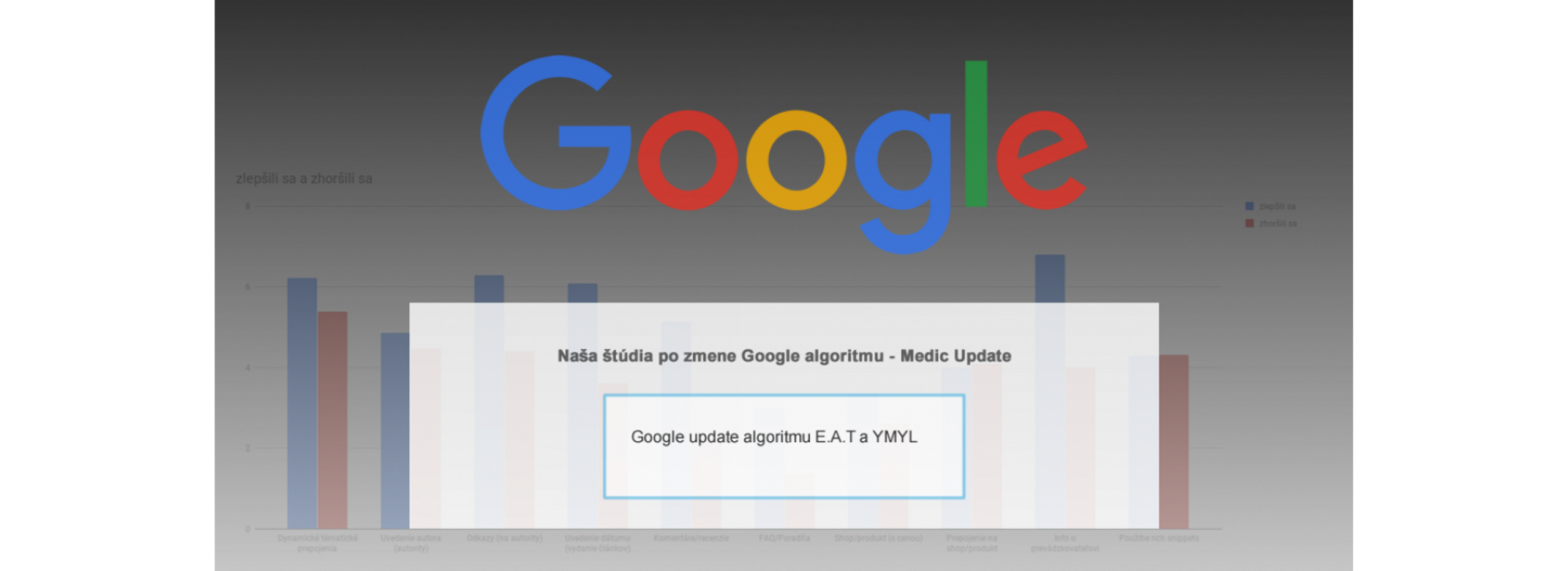
On August 1, 2018, Google revealed their new algorithm change on Twitter (Google SearchLiaison @searchliaison), what would be later called the Medic Update. A week after the update, we’ve published a blog – Google Update 01.08.2018 - E.A.T. a YMYL – where we summarized some of our observations and findings about this update. After publishing the blog, we decided to do some research of our own.
The result of it is a case study where we compared a number of websites and tried to identify differences and find out which pages improved their position and, on the contrary, which ones lost their ranking in Google’s SERP.
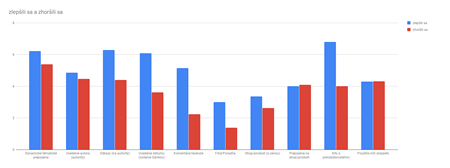
The case study compares 28 pages from various sources. We defined 10 basic criteria for which we wanted to verify their influence on the rankings after the update.
These criteria were taken from different sources and are also in compliance with Google’s Search Quality Evaluator Guidelines. We also confirmed/denied some of our assumptions about the impact of this algorithm change.
Moreover, we created a graph with the type of pages used in the case study.
Contents
- Dynamic Topic Linking
- Author of the Content
- Links to Authority Websites
- Date of The Content
- Comments/Reviews
- FAQ
- Shop/Product
- Linking of Shop/Product
- Information About the Owner of The Website
- Comparison of Website Types
- Sources
Dynamic Topic Linking
First, we analyzed whether the website dynamically interconnects its content, meaning it takes advantage of internal linkbuilding. However, this linkbuilding has to be logical and based on related topics (direct site links). For example, it is typical for ecommerce websites to link frequently asked questions (FAQ), reviews or blogs to their products.
In order to understand this better, let’s take a look at the following image taken from the WebSupport’s How does Drupal work? blog.
Imagine a car dealer website. The car dealer is dynamically linking the advertised car. For example: Škoda Octavia Combi 2.0i Collection is connected with the description of the model (Škoda Octavia) and each of the given content can link and also expand its information.
Examples:
- Let’s say you’re searching for “Škoda Octavia”. The description page of the model provides you with a description, but it can also serve you with related vehicles, thus thematically increasing its content.
- Another example. If you’re searching for “Škoda Octavia Combi 2.0i”, the car dealer’s website can provide you with general information about the car model and also about the dealer.
- If you’re searching for “Škoda car dealer”, the car dealer’s website can serve you with extended information about the advertised vehicles.
Websites that maintain their thematic content throughout the whole site have improved their rankings. We gave higher ratings to websites that have a logical and well-established internal linkbuilding. Internal links improve the website’s navigation and help users to be better oriented. Moreover, Google bots use links to crawl the website, so good internal linking can support their work, resulting in faster site crawling, while better understanding the content (intent of the website).
Author of the content
Displaying the author of the content and providing information about him/her is important from the perspective of reliability. This is especially important on content-heavy websites. We were examining whether the author is mentioned in the preview of the article (thumbnails), e.g. on the homepage, in listings, or only in the article itself.
Mainly those websites have improved their positions which display the authors of articles (this primarily applies to publisher websites). It is advised to show the author in the most trustworthy way possible, by displaying his full name (not just a nickname). The name of the author should be linking to his user profile on the page, where more additional information could be found about the person. The more information, the better – if Google can find a lot of information about the author, it means that the author must have a high authority. This can be achieved by publishing a lot of high-quality articles, receiving positive feedback from the readers, having mentions on Wikipedia, etc. This is especially true for YMYL websites.
In our case study, we focused more on healthcare websites. This area requires the author to have a degree from the mentioned field and also have years of experience with the matter in hand (available publications in various scientific journals, etc.) Publications on authoritative websites can boost the authority and trustworthiness of the author. If these requirements are not met, the credibility of the article – as well as the website – decreases.
Our study discovered, that displaying the author doesn’t affect the ranking by much, but it surely has an influence on the overall ranking of your website. But like we mentioned, you need to consider that certain types of websites simply require all the available information about the author.
An example from Google’s Search Quality Guidelines
It can be found in Google’s guidelines under Examples of Lowest Quality Pages.
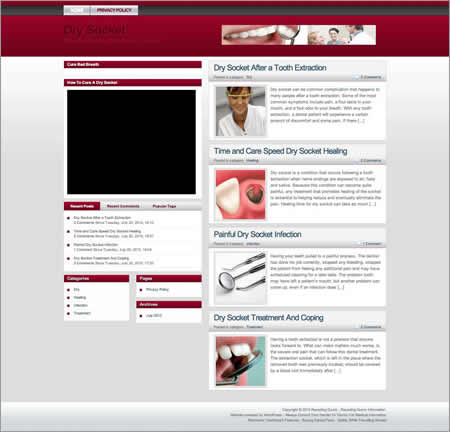
This healthcare website belongs to the category of YMYL sites – that’s why it should contain certain information specific for this type of pages.
But this one doesn’t provide any information about the author, we cannot find a contact page, nor any information about the authorship. Healthcare pages require certain degree of credibility.
Since the website doesn’t provide any information about the owner of the site and the author of the content, Google doesn’t consider this page trustworthy.
Links to Authority Websites
Information about the domains linking to a specific page – quality of the domain to be more precise – was obtained from the Ahrefs tool. As for the main ranking factors in this category we decided for the quantity, quality and relevance of the links.
On one side, it’s important how users perceive the website, but on the other, it’s also crucial to have high-quality external sources linking to it. We found out that the quantity of the links is less important.
Much more significant is the quality of the links and that the referring websites are similar in topic. It’s not just about referring to strong and authoritative sites, even though the content of those sites doesn’t match up.
Websites referring to thematically similar pages (e.g. healthcare sites) with higher authority were positively impacted by the new algorithm change from Google. Since we’re talking about healthcare sites – it is important that they link to verified and professional articles published by doctors and experts from the field of healthcare.
These “sources of reputation” referring to the website should be a creation of a human – articles on Wikipedia, blog posts, forum discussions.
Date of The Content
We didn’t find any statement from Google on how the date of the content influences the position of the page. Based on our case study, it might be one of the factors that have an influence on the overall ranking of the website. We were looking for publication dates of articles, comments, reviews, discussions and others.
Websites displaying the date of their content have improved their rankings. We don’t mean just the published dates of articles (or the latest update), but also dates of comments, reviews and other posts. Findings of our study suggest that Google prefers content which has a date. This is also mentioned in the guidelines for some low-ranking examples.
Comments/Reviews
This factor was evaluated based on the amount and relevance of comments. We also considered the possibility of commenting (some sites don’t allow comments). This also means whether you can post a comment anonymously – which results in lower credibility – or you have to register or provide your email address before commenting.
Considering certain types of pages (product pages, content sites, recipes, etc.), Google takes into consideration sections with comments and reviews. These reflect the trustworthiness of the website and provide Google with a clearer image. Ecommerce websites, which have really detailed products, secured a better position in the organic search results. By more detailed products we mean that there is a description, various parameters, reviews of the product, comments and discussion.
Websites providing product reviews from verified customers or enabling reviews only after signing up, have improved their positions. The more reviews on the site, the better. But once again, quality over quantity.
An example from Google’s Search Quality Guidelines
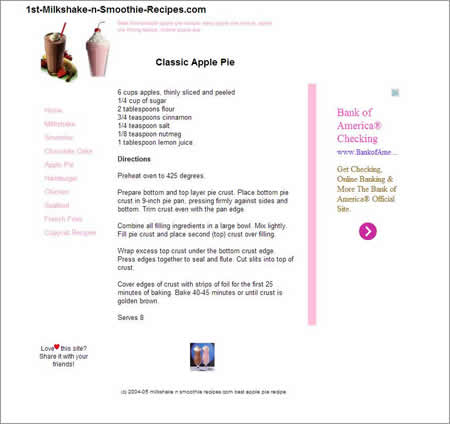
Again, we can found an example in the guidelines under Examples of Lowest Quality Pages
This website is missing comments and reviews, which Google considers as a major downside for this type of content such as recipes. Without this information, it is difficult for the user to determine whether the recipe is good or not. Again, the comments should be thematically related to the content on the page.
Google uses user-generated content, like comments, to determine the trustworthiness of the site based on the opinions of users.
Websites which did not provide comments or had a low number of comments, or contained negative views have worsened their positions in the search results.
FAQ
Similarly to comments and reviews, FAQ has an important role in assessing the quality of the site. Ecommerce websites, providing their customers with advice and FAQs (e.g. Heureka), have improved their rankings in Google’s SERP.
Similarly, websites with a dedicated page just for the frequently asked questions have also improved their positions. It seems to be very effective to provide visitors with relevant answers to their questions.
Shop/products (price included)
We examined whether the website focuses mainly on content creation or selling products/services.
Linking of Shop/Products
We explored whether the site reinforces products/ecommerce, or not.
Information About The Owner of The Website
We focused on sections that provide information about the owner and the intent of the website. We evaluated the complexity of these information – transparent information, contact information, social media and other connections.
The new Google update is looking for “trust pages” – pages that reveal all the important information about the site and its owner (About Us, Contact, Support). These pages should contain clear and transparent information about the website. You can learn more about trust pages in the Google guidelines.
A lot of these information depends on the type of the page. Naturally, healthcare, legal and financial websites must provide a sufficient amount of credible information that users (and Google, of course) find trustworthy.
It should be clear who’s responsible for the content on the website. The profiles of the authors should be visible on the site, along with links to their social media and other relevant sources, where Google can find out more information about them.
Websites that don’t fall in to the category of YMYL sites, don’t need such extensive amount of information about their authority as the ones mentioned above.
Comparison of Website Types
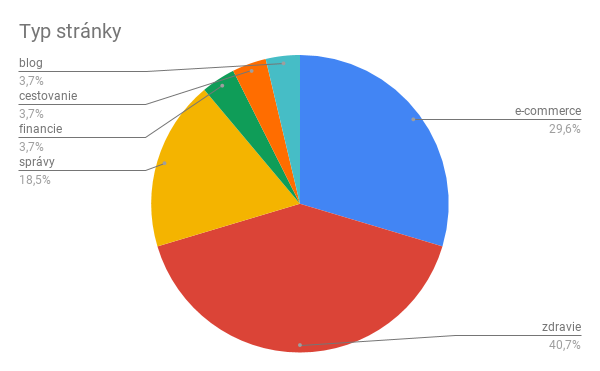
We want to hear your opinion. Did this new Google algorithm change affect your website? Did you experience any radical changes? Are there any key factors that we have missed? Let’s hear your opinion in the comments below!
